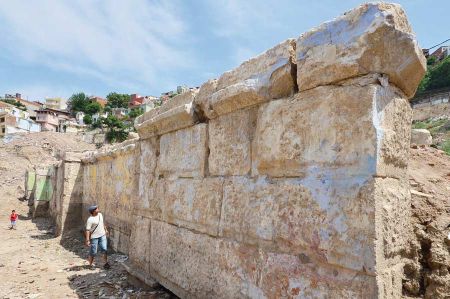Izmir - Expropriations allow exposure of Roman Amphitheatre
- Written by Portal Editor
It took many years and enormous costs until finally in Kadifekale, a district of Izmir, the excavation of one of the most important ancient theatres of Roman origin could begin.
In the meantime, some stage walls and the entrance area of the Roman amphitheatre of the former metropolis Smyrna have been uncovered.
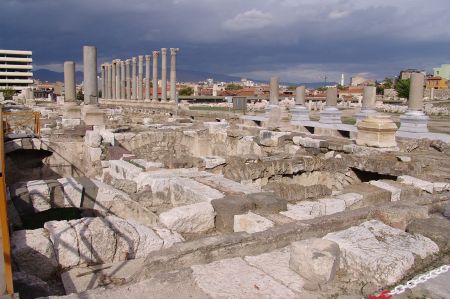 According to official information from the Izmir city administration, land and areas totalling 12,900 square meters had to be expropriated and transferred to municipal ownership. So far, 137 land registers covering an area of 11,115 square meters have been transferred to the city, so that 175 houses built on them have already been demolished. The legal process of expropriation for the last remaining houses is in the final phase, but will continue. In Turkey, illegal construction, often by settlers from the east, is often a problem.
According to official information from the Izmir city administration, land and areas totalling 12,900 square meters had to be expropriated and transferred to municipal ownership. So far, 137 land registers covering an area of 11,115 square meters have been transferred to the city, so that 175 houses built on them have already been demolished. The legal process of expropriation for the last remaining houses is in the final phase, but will continue. In Turkey, illegal construction, often by settlers from the east, is often a problem.
As soon as the last houses are demolished, scientists will begin their excavations and investigations. The two archaeologists and architects Otto Berg and Otto Walter from Austria could make a significant contribution to this, since their studies, plans and drawings of the region from 1917 and 1918 provide them with the most well-founded knowledge of the ancient amphitheatre of Smyrna.
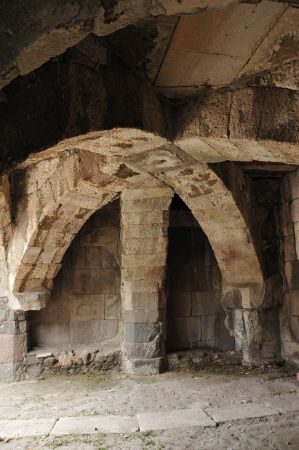 The reports of many researchers indicate that the ruins of the theatre show characteristic features of a structure from the Roman era and it is calculated that up to 16,000 spectators could be seated in the theatre at one time.
The reports of many researchers indicate that the ruins of the theatre show characteristic features of a structure from the Roman era and it is calculated that up to 16,000 spectators could be seated in the theatre at one time.
Ancient sources claim that St. Polycarp of Smyrna was killed in this amphitheatre in the early years of Christianity. It is also assumed that many other fates ended tragically in the theatre, because the Romans, with their pagan beliefs, persecuted the young Christianity wherever possible. Saint Polycarp of Smyrna, believed to have been born around AD 69, was Bishop of Smyrna in the 2nd century. According to tradition, he was 86 years old at the time of his death. He was probably executed by the Romans in 155. He is also called the destroyer of the pagan gods.
Polycarp - Apostolic Father and Bishop of Smyrna
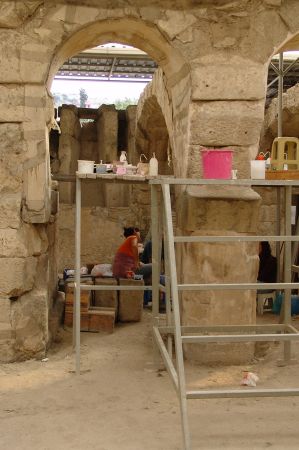 Church tradition sees Polycarp as an apostolic father, someone who personally knew the original apostles from the time of Jesus of Nazareth. Irenaeus reports that Polycarp was appointed bishop of Smyrna by the apostle John, but the writings of Ignatius and Papias point to John the presbyter. Since the assumption of a monarchical bishopric as early as the 1st century contradicts the sources - even in the letter of Clement to the Corinthians there are only references to elders, but no reference to a monarchical bishop - the question of his episcopate is irrelevant anyway.
Church tradition sees Polycarp as an apostolic father, someone who personally knew the original apostles from the time of Jesus of Nazareth. Irenaeus reports that Polycarp was appointed bishop of Smyrna by the apostle John, but the writings of Ignatius and Papias point to John the presbyter. Since the assumption of a monarchical bishopric as early as the 1st century contradicts the sources - even in the letter of Clement to the Corinthians there are only references to elders, but no reference to a monarchical bishop - the question of his episcopate is irrelevant anyway.
As Bishop of Smyrna, Polycarp met with Aniket, the Bishop of Rome, in Rome in 155 to settle questions about the date of Easter. The Eastern Church celebrated Easter on the Jewish Passover, no matter what day of the week it fell (quarto deciman). The Western Church, on the other hand, celebrated Easter on the first Sunday after Passover. The Easter dispute was not settled at that time; both sides maintained their practice.
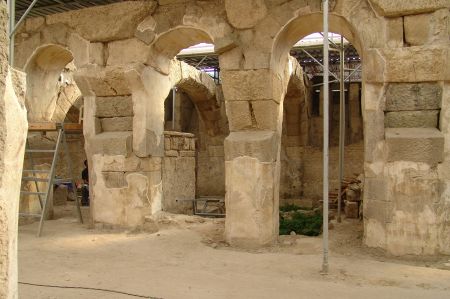 On his return to Smyrna, Polycarp was arrested. He stood by his faith, and when asked by the proconsul to deny Christianity, he even offered him an appointment for instruction in the Christian faith.
On his return to Smyrna, Polycarp was arrested. He stood by his faith, and when asked by the proconsul to deny Christianity, he even offered him an appointment for instruction in the Christian faith.
Eventually it was paraded in the amphitheatre for popular amusement. The Proconsul refused to let Polycarp be mauled by animals because that point of the program had already ended, but he allowed Polycarp to be burned. The people immediately took matters into their own hands; amidst the cheering crowd he was burned at the stake at the age of 86.
According to legend, however, the flames could not harm him, and a pleasant smell rose from the pyre. Finally, Polycarp had to be stabbed with a dagger.
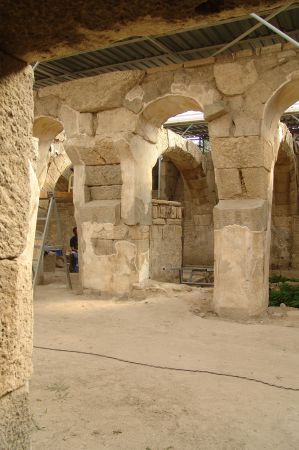 The details of his death are recounted in the second-century Martyrdom of Polycarp, addressed by the church in Smyrna to that in Philomelium. The Martyrdom of Polycarp was very popular and widespread in the early church. This text is also of historical interest as one of the very few authentic contemporary descriptions (eyewitness account) of a persecution of Christians in the 2nd century.
The details of his death are recounted in the second-century Martyrdom of Polycarp, addressed by the church in Smyrna to that in Philomelium. The Martyrdom of Polycarp was very popular and widespread in the early church. This text is also of historical interest as one of the very few authentic contemporary descriptions (eyewitness account) of a persecution of Christians in the 2nd century.
Polycarp is considered a martyr and recognized as a saint by the Catholic and Orthodox Churches. Relics of the saint are on the high altar of the church of Sant'Ambrogio della Massima.
It remains to be seen whether further findings can be found during the forthcoming excavations. It's always exciting. The city government has plans after the end of the excavations to restore the theatre and use it again for events comparable to those in Ephesus.
Please read as well:
De 1800 Roeden – cultural park worth seeing in Amsterdam
Serhat Dogan - His view of German habits
-
 Izmir - now new excavation are possible
Izmir - now new excavation are possible
Izmir - now new excavation are possible
Izmir - now new excavation are possible
-
 Izmir - now new excavation are possible
Izmir - now new excavation are possible
Izmir - now new excavation are possible
Izmir - now new excavation are possible
-
 Izmir - now new excavation are possible
Izmir - now new excavation are possible
Izmir - now new excavation are possible
Izmir - now new excavation are possible
-
 Izmir - now new excavation are possible
Izmir - now new excavation are possible
Izmir - now new excavation are possible
Izmir - now new excavation are possible
-
 Izmir - now new excavation are possible
Izmir - now new excavation are possible
Izmir - now new excavation are possible
Izmir - now new excavation are possible
-
 Izmir - now new excavation are possible
Izmir - now new excavation are possible
Izmir - now new excavation are possible
Izmir - now new excavation are possible
-
 Izmir - now new excavation are possible
Izmir - now new excavation are possible
Izmir - now new excavation are possible
Izmir - now new excavation are possible
-
 Izmir - now new excavation are possible
Izmir - now new excavation are possible
Izmir - now new excavation are possible
Izmir - now new excavation are possible
-
 Izmir - now new excavation are possible
Izmir - now new excavation are possible
Izmir - now new excavation are possible
Izmir - now new excavation are possible
-
 Izmir - now new excavation are possible
Izmir - now new excavation are possible
Izmir - now new excavation are possible
Izmir - now new excavation are possible
-
 Izmir - now new excavation are possible
Izmir - now new excavation are possible
Izmir - now new excavation are possible
Izmir - now new excavation are possible
-
 Izmir - now new excavation are possible
Izmir - now new excavation are possible
Izmir - now new excavation are possible
Izmir - now new excavation are possible
https://www.alaturka.info/en/turkey-country/aegean/6238-izmir-expropriations-allow-exposure-of-roman-amphitheatre?layout=default#sigProId9e0bf01e72
